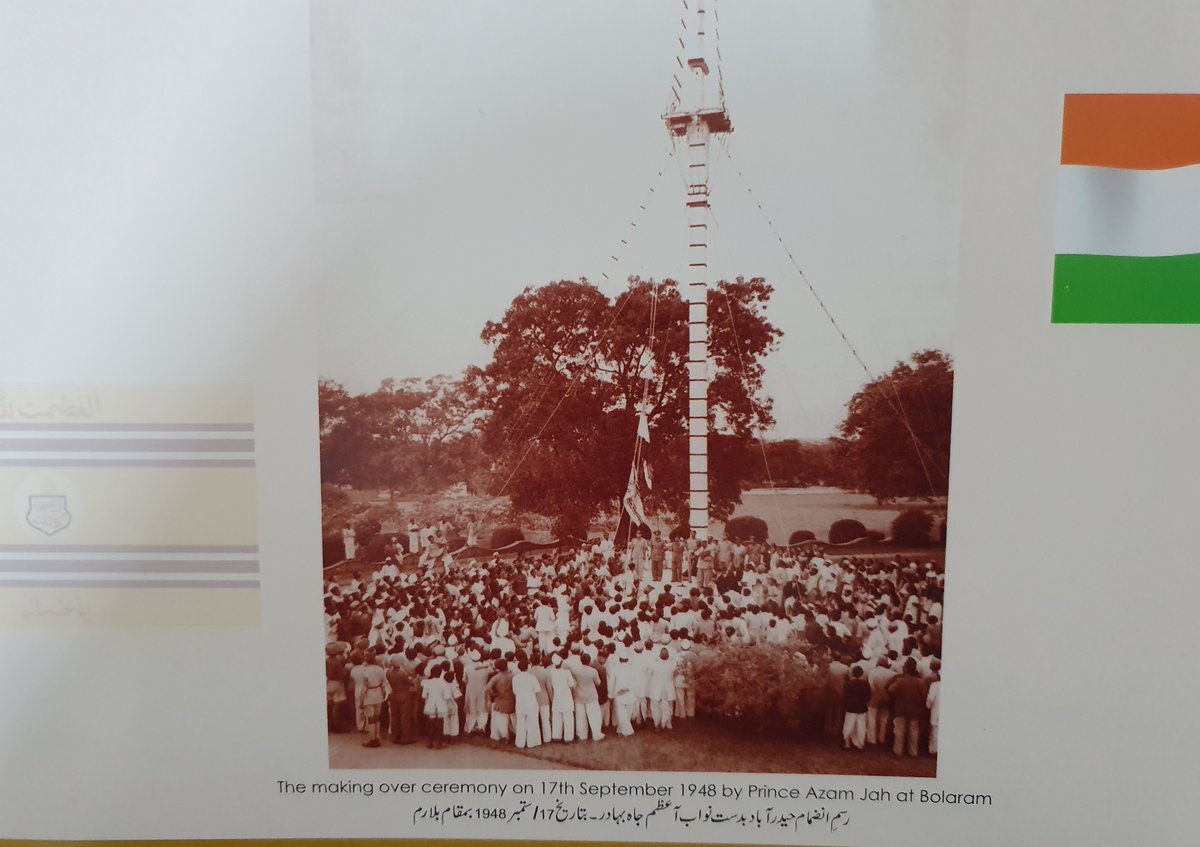
'#Hyderabad Liberation Day' THREAD:
Remembering Makhdoom Mohiuddin, communist legend and (one of the) leaders(s) of the anti-Nizam/anti-feudal #Telangana Armed Struggle (1946-51)
Saw CPI workers paying tributes to one of our most progressive figures. Here's more about his life

Remembering Makhdoom Mohiuddin, communist legend and (one of the) leaders(s) of the anti-Nizam/anti-feudal #Telangana Armed Struggle (1946-51)
Saw CPI workers paying tributes to one of our most progressive figures. Here's more about his life


The irony of the BJP’s 'Liberation day' observance is that it was literally a non-player in 1948. Its ideological parent,the RSS, was barely present. In Telangana, it was the Communist Party of India which had taken over most of the rural areas. People like Makhdoom headed it.
Some background: After the British formally left India in 1947, it gave monarchs of princely states the option to join India/Pakistan or to stay independent.
Osman Ali Khan was one of the handful of kings, like Hari Singh of Jammu and Kashmir, who wanted to stay independent
Osman Ali Khan was one of the handful of kings, like Hari Singh of Jammu and Kashmir, who wanted to stay independent
After all, he was the king of the largest princely state, Hyderabad, which comprised 16 districts in 1948 (8 in Telangana, 5 in Maharashtra and 3 in Karnataka).
Osman Ali Khan was also one of the richest men in the world, and was the king of a relatively peaceful state.
Osman Ali Khan was also one of the richest men in the world, and was the king of a relatively peaceful state.
However, the underbelly of it, especially in Telangana’s districts, was that of extreme oppression by state-appointed Jagirdars (landlords), whose main task was to collect revenue (taxes and rent) from farmers and give it to the state. The landlords were anything but benevolent.
Vetti Chakiri (bonded labour) was also commonplace in rural Telangana, wherein lower-caste folks were forced to service the higher castes and the landowning class. The Nizam (of Hyderabad) himself had directly owned 10% of the state’s lands, while 60% of it were revenue lands
Bonded labour/forced collections were the main reasons behind the uprising. It began in 1946, & officially ended in 1951, till the communists decided to contest elections.The CPI's biggest leaders from Telangana then were Makhdoom Mohiuddin, Ravi Narayan Reddy,Rajeshwar Rao, etc
bu Sayeed Mohammed Makhdoom Mohiuddin Khudri was on February 4, 1908. He was the son of Ghouse Mohiuddin, a superintendent at the Tahsil office in Andol, Medak district. His father died at a very young age and he was raised by his uncle Basheeruddin.
Starting with lyrical poetry around 1933-34, Makhdoom Mohiuddin completed the study of almost all Urdu & Persian classical & works. He was soon drawn towards progressive, anti-imperial, socialist and anti-fascist thought. Under the Nizam, the the CPI had been banned in the 40s.
As his ties with the communists grew, he eventually also organised a student union in 1939-40. Politically charged, the period coincided with the rise of the Majilis-e-Ittehadul Muslimeen. Other groups like the Arya Samaj & Congress were also active in the state.
Makhdoom, who began organising trade unions in the Hyderabad state, was arrested in 1946 as he had a warrant against him. He was soon released. He eventually had to go online as the Armed Struggle continued till 1951, 3 years after the Hyd state was annexed to India in 1948
Makhdoom was also jailed for a while and was one of those from the CPI who wanted to reconsider the armed struggle. During his prison time in 1951, he wrote his then famous poem ‘Qaid’. One of his most famous poems, essentially a battle cry against landlords, was ‘Jang-e-Azadi’.
Makhdoom is today mostly known as an Urdu poet, as many for political reasons detach him from his communism.
His fellow CPI legend Raj Bahadur Gaur also remarked in his book that a “trend” to assert “Makhdoom the artist” was different from “Makhdoom the communist” had developed.
His fellow CPI legend Raj Bahadur Gaur also remarked in his book that a “trend” to assert “Makhdoom the artist” was different from “Makhdoom the communist” had developed.
However, many who knew him, and are still around, say that Makhdoom was not in any such conflict. “So, Makhdoom the Communist and Makhdoom the Poet, both worked and wrote for the same cause -‘Victory for Love and Labour’, wrote Raj Bahadur Gaur about his former comrade.
siasat.com/hyderabad-libe…
Wrote a detailed piece on his life to talk about the lesser known people and aspects of Operation Polo and the Telangana Armed Struggle. More soon to follow !
#HyderabadLiberationDay
Wrote a detailed piece on his life to talk about the lesser known people and aspects of Operation Polo and the Telangana Armed Struggle. More soon to follow !
#HyderabadLiberationDay
Had to go underground**
Apologies
Apologies
• • •
Missing some Tweet in this thread? You can try to
force a refresh








